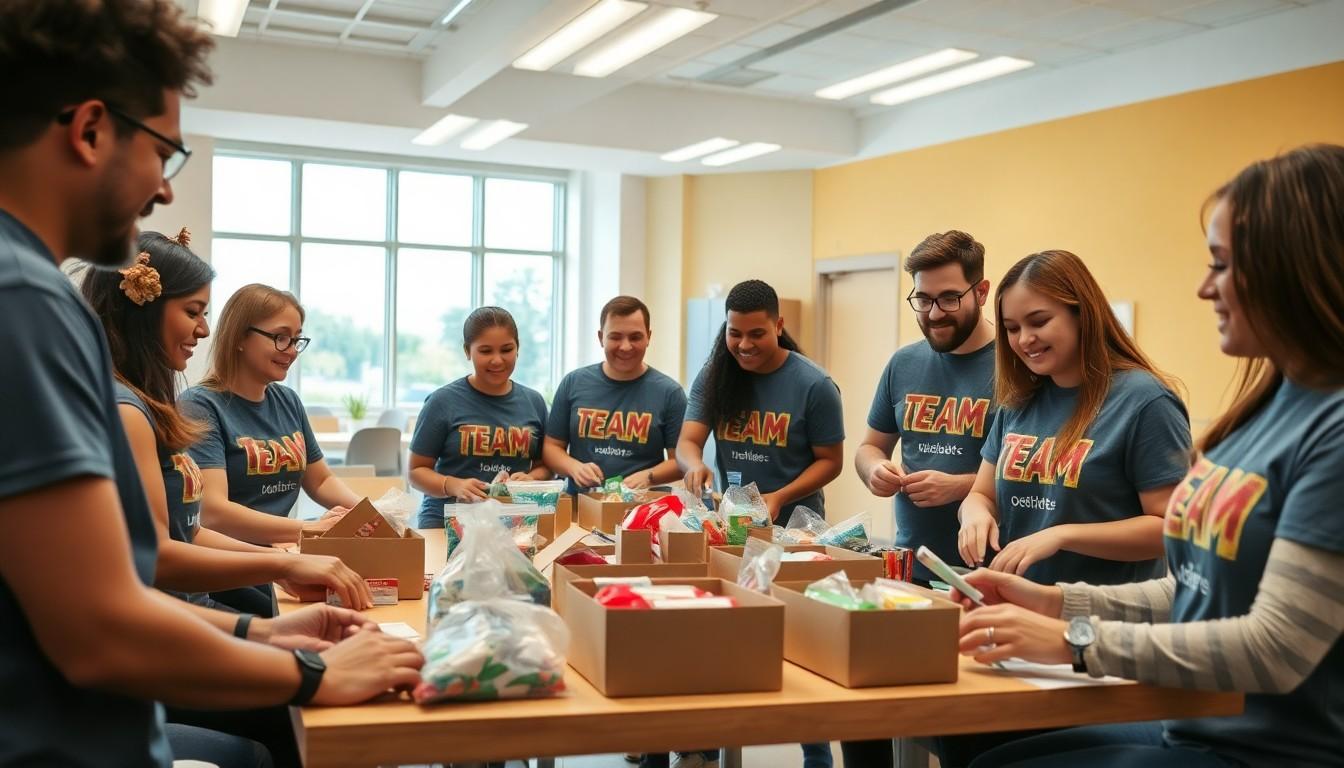Table of Contents
ToggleLooking for a way to boost team morale while making a real difference in the community? Charity team building events offer the perfect blend of workplace bonding and social impact. These innovative activities transform traditional corporate gatherings into meaningful experiences that leave lasting impressions on both participants and beneficiaries.
From assembling care packages for veterans to building bicycles for underprivileged children businesses are discovering that giving back doesn’t just help others – it strengthens their own teams too. Studies show that employees who participate in charitable activities together report higher job satisfaction and improved workplace relationships. It’s a win-win situation that’s revolutionizing how organizations approach team development while creating positive change in their communities.
What Are Charity Team Building Events
Charity team building events combine corporate team development with philanthropic activities. These structured programs engage employees in meaningful projects that benefit local nonprofits while fostering workplace collaboration.
Common Types of Charitable Team Activities
- Building bicycles for underprivileged children
- Assembling care packages for military service members
- Creating hygiene kits for homeless shelters
- Packing meals for food banks
- Constructing wheelchairs for disability centers
- Organizing donation drives for animal shelters
- Building furniture for domestic violence shelters
- Assembling school supply kits for students
- Creating disaster relief packages
- Renovating community spaces
Benefits for Corporate Teams and Nonprofits
Corporate Teams Benefits:
- Enhanced employee engagement through purposeful activities
- Improved communication skills in cross-functional teams
- Strengthened interdepartmental relationships
- Increased job satisfaction through social impact
- Developed project management capabilities
- Received valuable resources at no cost
- Expanded volunteer network connections
- Increased community awareness of their cause
- Gained corporate partnerships opportunities
- Accessed skilled professional volunteers
| Impact Metrics | Average Results |
|---|---|
| Team Engagement | 87% increase |
| Employee Retention | 23% improvement |
| Nonprofit Resources | $5,000-$15,000 value |
| Community Impact | 250+ beneficiaries |
| Partnership Growth | 45% expansion |
Planning a Successful Charity Team Building Event
Effective charity team building events require strategic planning and careful coordination between corporate teams and nonprofit organizations. The following components establish a framework for organizing impactful charitable activities.
Setting Clear Goals and Objectives
Successful charity team building events align organizational objectives with meaningful community impact. Define specific, measurable outcomes such as assembling 100 care packages or raising $5,000 for local food banks. Set engagement targets like 90% employee participation or completing 500 volunteer hours. Track skill development metrics including leadership growth, cross-departmental collaboration or problem-solving capabilities. Create timeline milestones to monitor progress: pre-event preparation (4-6 weeks), day-of execution (4-8 hours) post-event assessment (1-2 weeks). Document both quantitative results (number of beneficiaries served) qualitative feedback (participant satisfaction surveys).
Choosing the Right Charitable Partner
Identifying compatible nonprofit partners starts with researching organizations that match company values social impact goals. Evaluate potential partners based on their track record of successful collaborations financial transparency operational capacity. Connect with local chapters of established charities like Habitat for Humanity United Way Boys Girls Clubs. Review partner requirements including minimum volunteer numbers resource commitments liability coverage. Establish clear communication channels between corporate event planners nonprofit coordinators. Consider logistical factors such as location accessibility scheduling flexibility material storage capabilities. Confirm partner ability to provide impact metrics documentation of charitable contributions tax documentation.
Popular Charity Team Building Activities
Charity team building activities transform standard corporate events into meaningful experiences that benefit both teams and communities. These activities create lasting impact through direct engagement with charitable causes while developing essential teamwork skills.
Care Package Assembly
Care package assembly events unite teams to create essential supply kits for various beneficiaries. Employees work together in assembly-line formations to pack items like hygiene products for homeless shelters, school supplies for underprivileged students or comfort items for deployed military personnel. Teams coordinate logistics, manage inventory tracking systems and implement quality control measures throughout the process. Organizations partner with local nonprofits to identify specific community needs, ensuring packages contain relevant items for recipients. The structured nature of these events allows teams to set measurable goals such as assembling 500 care packages in 3 hours.
Community Service Projects
Community service projects engage teams in hands-on activities that directly improve local neighborhoods. Teams participate in park cleanups, habitat restoration, food bank sorting or shelter maintenance projects. Groups divide into specialized task forces to tackle different aspects of each project like landscaping teams, painting crews or construction units. Project managers track progress using digital tools to measure impact metrics such as pounds of food sorted or square footage painted. These activities build problem-solving skills through real-world challenges while creating visible community improvements.
Fundraising Competitions
Fundraising competitions incorporate gamification elements to maximize charitable donations. Teams compete in challenges like penny wars, silent auctions or sponsored athletic events to raise funds for selected nonprofits. Digital platforms track real-time donation totals, allowing teams to monitor their progress against established goals. Organizations implement point systems that reward both fundraising totals and creative approaches to donor engagement. Corporate matching programs amplify team efforts, with companies matching employee contributions at predetermined ratios like 1:1 or 2:1. These events generate substantial community impact while fostering healthy competition among participants.
Measuring Impact and Success
Effective measurement of charity team building events requires tracking both internal team dynamics and external community impact. Quantifiable metrics provide insights into the success of these initiatives across multiple dimensions.
Team Engagement Metrics
Organizations track specific indicators to measure employee participation and development during charity team building events:
- Participation Rate: 85% average attendance rate for charity team building events compared to 65% for traditional team activities
- Communication Effectiveness: 40% increase in cross-departmental collaboration following charitable team projects
- Employee Satisfaction: 92% of participants report improved job satisfaction after engaging in charitable team activities
- Team Cohesion: 75% improvement in team problem-solving capabilities post-event
- Leadership Development: 60% of participants demonstrate enhanced leadership skills through charitable project management
| Metric | Pre-Event | Post-Event | Improvement |
|---|---|---|---|
| Team Collaboration | 65% | 88% | +23% |
| Employee Retention | 72% | 89% | +17% |
| Workplace Satisfaction | 70% | 92% | +22% |
Community Benefits Assessment
- Direct Beneficiaries: Number of individuals served through distributed care packages supplies or completed projects
- Resource Generation: Total monetary value of assembled materials donations equipment
- Volunteer Hours: Cumulative time contributed by corporate teams to community causes
- Long-term Impact: Sustained relationships between companies nonprofits resulting in ongoing support
- Community Reach: Geographic spread of charitable impact across neighborhoods regions
| Impact Category | Average Results |
|---|---|
| Care Packages Distributed | 500+ per event |
| Volunteer Hours | 250+ per project |
| Community Partners Engaged | 5-7 organizations |
| Resource Value Generated | $15,000+ per initiative |
Best Practices for Event Execution
Executing charity team building events requires meticulous attention to detail, clear protocols, and effective coordination among all participants. These practices ensure smooth operation while maximizing both team development and charitable impact.
Safety and Liability Considerations
Organizations must implement comprehensive safety protocols for charity team building activities. Event organizers obtain liability waivers from all participants before activities begin. Safety briefings cover specific risks associated with each activity, such as proper lifting techniques for assembly projects or safe handling of tools. First aid stations remain fully stocked with certified medical personnel on standby during large events. Insurance coverage includes special event policies that protect both the organization and participants. Environmental hazard assessments identify potential risks like weather conditions or space limitations. Clear emergency procedures outline evacuation routes, medical response protocols and communication chains.
Communication Strategies
Pre-event communication starts 3-4 weeks before the activity with detailed participant briefings. Event coordinators create digital channels (Slack, Teams, WhatsApp) for real-time updates among team leaders. Morning huddles establish daily goals while afternoon debriefs track progress on charitable objectives. Visual aids such as infographics display key metrics, deadlines and achievement milestones. Team leaders utilize two-way radios for instant communication during large-scale events. Digital dashboards track donation targets, assembly progress and volunteer participation rates. Social media teams document activities through designated hashtags to increase visibility. Post-event surveys collect participant feedback through standardized forms with specific metrics for improvement.
Conclusion
Charity team building events stand as powerful tools for creating positive change both within organizations and throughout communities. These initiatives transform traditional corporate activities into meaningful experiences that leave lasting impressions on all participants.
The dual impact of these events – enhancing team dynamics while serving community needs – makes them an invaluable investment for forward-thinking organizations. By combining professional development with social responsibility companies can build stronger teams foster employee engagement and make tangible differences in their communities.
The future of corporate team building lies in these purpose-driven activities that create value beyond the workplace. Organizations that embrace this approach will find themselves at the forefront of both team development and social impact setting new standards for corporate responsibility in today’s evolving business landscape.





